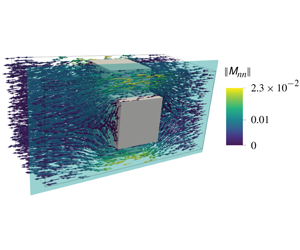Article contents
Effective stress jump across membranes
Published online by Cambridge University Press: 01 April 2020
Abstract

A macroscopic condition to simulate the interaction between an incompressible fluid flow and a permeable micro-structured rigid surface (i.e. a thin membrane) has been developed using multiscale homogenization and matching asymptotic expansions between the near membrane and the far region. The condition allows us to write the fluid velocity across the membrane, seen macroscopically as a smooth equivalent surface, as an effective jump between the stresses computed on the two faces of this surface. The coefficients appearing in the jump condition are the entries of tensors which solve Stokes problems within the pores, enforced by boundary conditions depending on the flow outside the membrane. These problems, found via homogenization, definitely characterize the microscopic geometrical properties of thin permeable micro-structured sheets. The new macroscopic model is validated by comparisons with direct numerical simulations of the fluid flow across membranes in different configurations, proving that the formalism adopted to write the jump conditions is valid. As a result, a rational tool able to join a microscopic and a macroscopic analysis of fluid flows across membranes is delivered, showing some potentialities to provide advancement in membrane design. It suggests that the concept of permeability has to be substituted by a more general tensor, called here the Navier tensor, which plays the role of permeability only in some particular situations.
JFM classification
- Type
- JFM Papers
- Information
- Copyright
- © The Author(s), 2020. Published by Cambridge University Press
References
- 15
- Cited by


